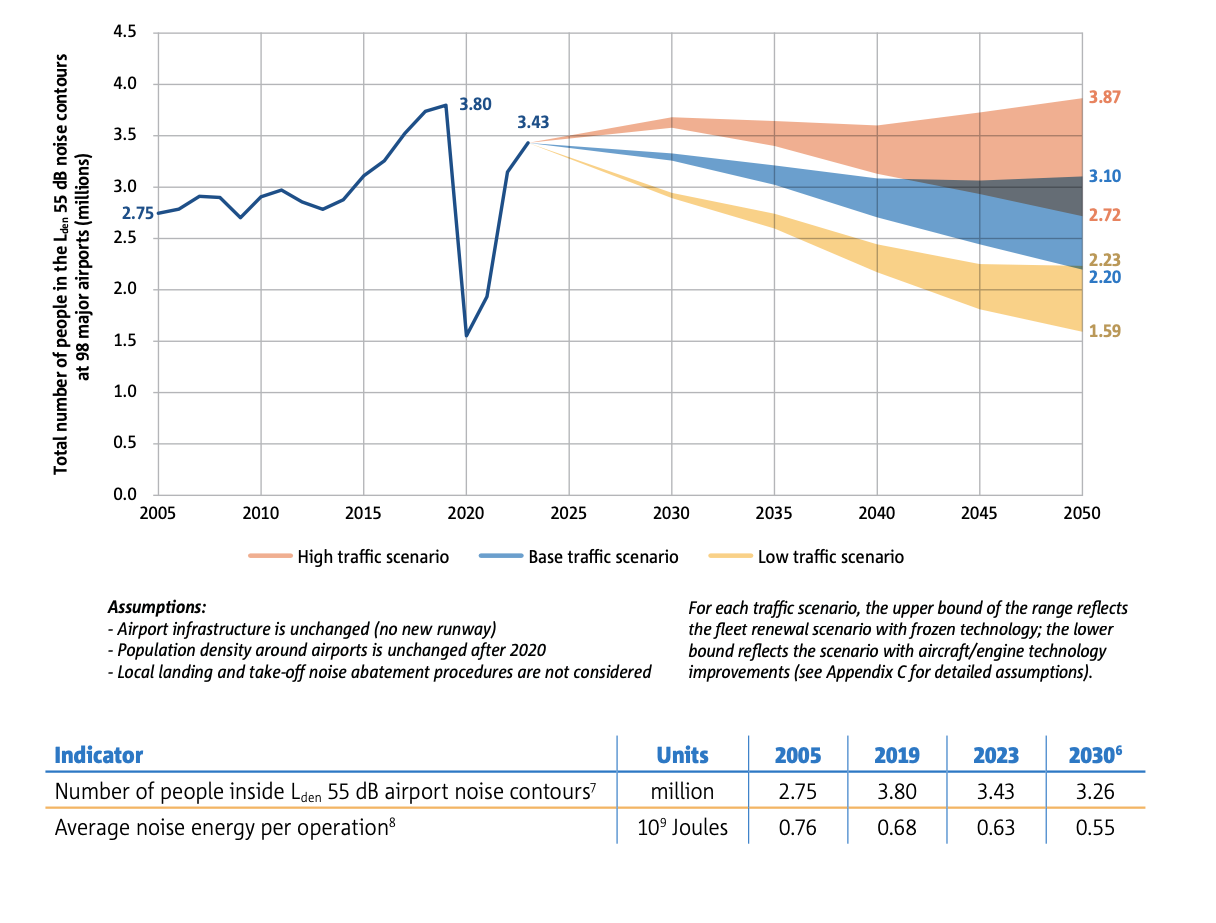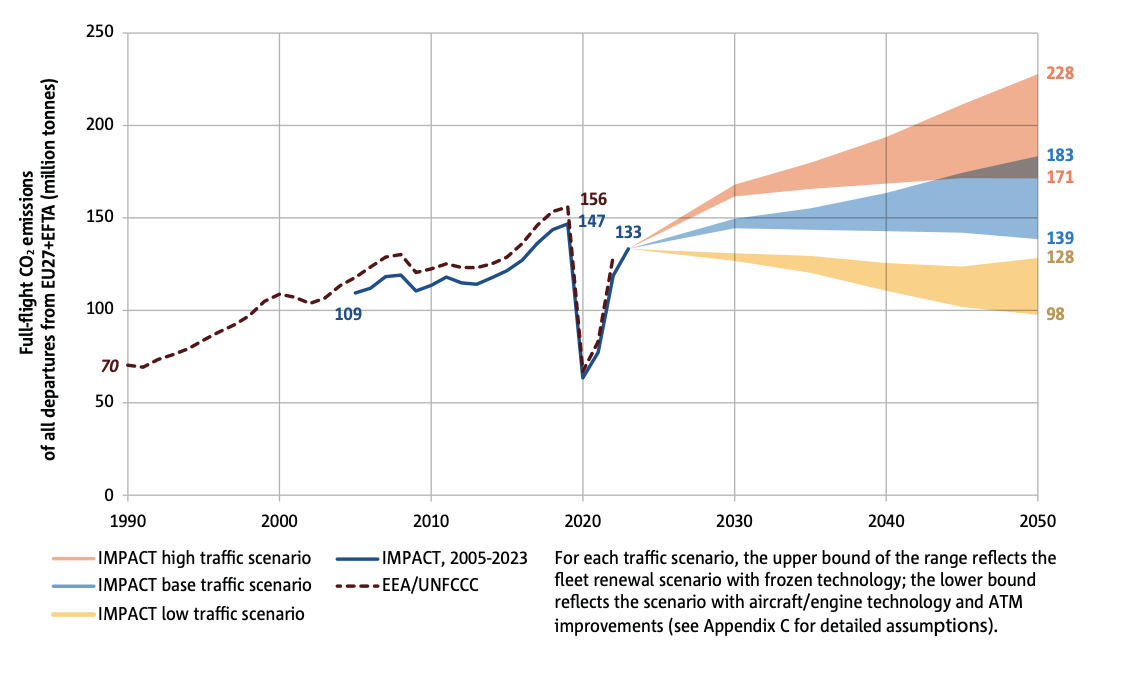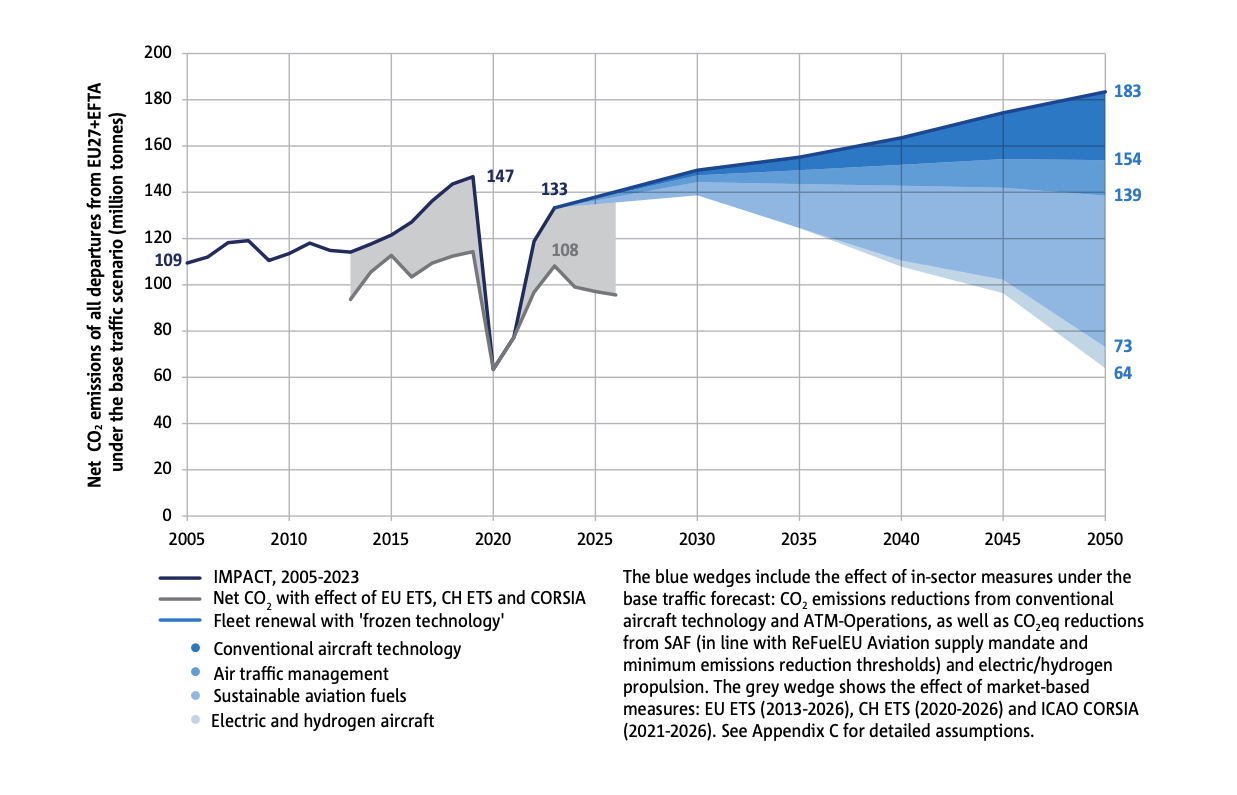The number of flights arriving at and departing from EU27+EFTA airports reached 8.35 million in 2023, which is still 10% below the pre-COVID 2019 level.
Low-cost operators have recovered faster from the COVID crisis than mainline operators.
Since February 2022, flight operations have been affected by the war in Ukraine and the subsequent airspace and operator restrictions. From October 2023, some re-routings have also been caused by the conflict in the Middle East.
The average number of passengers (135) and distance (1 730 km) per flight continues to grow, as does the average fleet age (11.8 years).
Future traffic growth was revised downwards compared to previous outlook, with 9.4, 11.8 and 13.8 million flights now foreseen in 2050 under the low, base and high traffic scenario respectively.
At 98 major European airports during 2023, 3.4 million people were exposed to Lden 55 dB aircraft noise levels and 1.6 million people were exposed to more than 50 daily aircraft noise events above 70 dB.
While the total European airport noise exposure is still slightly below 2019 levels, there are different trends at the individual airport level with an increase in noise exposure at about one third of these major airports between 2019 and 2023.
Single-aisle jets generated 71% of the total landing and take-off noise energy in EU27+EFTA during 2023.
Fleet renewal could lead to a reduction in total noise exposure at European airports as measured by the Lden and Lnight indicators over the next twenty years. However, the evolution of these indicators may differ significantly between airports.
In 2023, flights departing from EU27+EFTA airports emitted 133 million tonnes CO2, which is 10% less than in 2019. Single and twin-aisle jets accounted for 77% of these flights and 96% of the CO2 emissions. 6% of the flights were long-haul (>4 000 km) and accounted for 46% of the CO2.
The average mass of CO2 emitted per passenger kilometre further reduced to 83 grams in 2023, equivalent to 3.3 litres of fuel per 100 passenger kilometres.
Market-based measures should help stabilise European aviation’s net CO2 emissions in the short term.
Meeting the ReFuelEU Aviation supply mandate for sustainable aviation fuels could cut the net CO2 emissions by at least 65 million tonnes (47%) in 2050.
NOX emissions have grown faster than CO2 emissions since 2005 and are expected to continue to do so without further improvement in engine technology.
In 2021, the sector accounted for 10% of the population exposed to transport noise above Lden 45 dB in EU27+EFTA.
In 2022, flights departing from EU27+EFTA represented 12% of total transport greenhouse gas (GHG) emissions and 4% of total GHG emissions in EU27+EFTA.
Latest IPCC, WMO and Copernicus Climate Change Service all highlight widespread, rapid and record- breaking changes in the climate and extreme weather events, with Europe warming twice as fast as the global average making it the fastest warming continent in the world.
The overall climate impact from aviation is a combination of both its CO2 and non-CO2 emissions (e.g. NOX, PM, SOX, water vapour and subsequent formation of contrail-cirrus clouds).
The estimated Effective Radiative Forcing (ERF) from historic non-CO2 emissions between 1940 and 2018 accounted for more than half of the aviation net warming effect, but the level of uncertainty from the non-CO2 effects is 8 times higher than that of CO2.
Further research on the climate impact of non-CO2 emissions from aviation, especially on induced changes in cloudiness and methodologies to estimate aircraft GHG inventories, is required to reduce uncertainties and support robust decision-making.
Emissions with a short-term climate impact (e.g. NOX) can be expressed as equivalent to emissions with long- term climate impacts (e.g. CO2) in order to assess trade- offs of mitigation measures, but this is influenced by the metric and time horizon used.
A non-CO2 MRV framework began on 1 January 2025 aiming at monitoring, reporting and verifying the non- CO2 emissions produced by aircraft operators. This framework is designed to provide valuable data for scientific research that will enhance our understanding of non-CO2 effects and help address aviation climate impacts more effectively.
A European Parliament pilot project was launched in 2024 to explore the feasibility of optimizing fuel composition in order to reduce the environmental and climate impacts from non-CO2 emissions without negatively impacting safety (e.g. lower aromatics, sulphur).
The Aviation Non-CO2 Expert Network (ANCEN) has been established to facilitate coordination across stakeholders and to provide objective and credible technical support that can inform discussions on potential measures to reduce the climate impact from non-CO2 emissions.
Aviation adaptation and resilience to climate change will be critical to address projected future trends in hazardous weather events (e.g. severe convective storms and clear air turbulence) and changes to climatic and environmental conditions (e.g. sea level rise, changes to prevailing surface winds, upper atmosphere turbulence).
Aircraft engine emissions (mainly NOX and particulate matter) impact air quality around airports. Exposure to NO2 and ultrafine particles levels from aviation could be significant in residential areas in the vicinity of airports.
The Environmental Noise Directive 2022 data estimates 649 000 people experience high levels of annoyance due to aircraft noise, while 127 000 suffer from significant sleep disturbances.
The REACH12 Regulation restrictions on Substances of Very High Concern (e.g. chromium trioxide, PFAS) are impacting the aviation sector due to the absence of immediate alternatives.
There have been a limited number of new certified large transport aircraft and engine types over the last few years with marginal environmental improvements, while deliveries of the latest generation of aircraft continue to penetrate the European fleet.
The average margin to the latest noise standard of new regional, single-aisle and twin-aisle jet deliveries is levelling off, and the rate of deliveries is still recovering from the COVID crisis.
Certification of all in-production aircraft types against the ICAO CO2 standard is required by 1 January 2028, which is leading to an increase in activities within this area.
All new aircraft joining the European fleet since 2020 have engines that meet the latest CAEP/8 NOX standard, thereby suggesting a need to review this standard during the CAEP/14 work programme (2025-2028).
Environmental technology standards will be important in influencing new aircraft and engine designs and contributing to future sustainability goals.
In February 2025 the ICAO CAEP is aiming to agree on new aircraft noise and CO2 limits that would become applicable in the next five years.
Discussions have been initiated within ICAO CAEP to review the noise limits for light propeller-driven aircraft and helicopters, which have been unchanged since 1999 and 2002 respectively.
ICAO independent experts medium-term (2027) and long-term (2037) technology goals were agreed in 2019 and are becoming outdated.
Emissions data measured during the engine certification process acts as an important source of information to support modelling of operational emissions in cruise.
There have been further developments within the low carbon emissions aircraft market (e.g. electric, hydrogen), with support from the Alliance for Zero- Emissions Aircraft to address barriers to entry into service and facilitate a potential reduction in short / medium-haul CO2 emissions of 12% by 2050.
EASA has published noise measurement Guidelines and Environmental Protection Technical Specifications in order to respond to the emerging markets of Drones and Urban Air Mobility.
EASA has launched a General Aviation Flightpath 2030+ program to accelerate the transition of propulsion technology, infrastructure and fuels to support sustainable operations.
Horizon Europe, with a budget of €95 billion, is funding collaborative and fundamental aviation research, as well as partnerships (e.g. Clean Aviation, Clean Hydrogen) who are developing and demonstrating new technologies to support the European Green Deal.
The Single European Sky (SES2+) proposal of the Commission was formally adopted by the Council and the European Parliament in 2024, although only modest progress was made and various issues were left unresolved.
Implementation of SES2+, and a focus on continuous improvement to address unresolved issues, is critical to enhance capacity, efficiency and sustainability.
RP4 (2025-2029) SES performance targets reflect the ambition to enhance environmental performance, as does the desire to develop improved environmental monitoring indicators while building up resilience and strengthening capacity.
It is recognized that the SES performance scheme needs to be improved in terms of the ATM-related performance indicators for environment. Work is ongoing to identify a more robust KPI which, after a period of monitoring and analysis during RP4, will be ready for performance target setting in RP5 (2030-2034).
Updated SES ATM Master Plan has been aligned with the RP4 ambitions such that ANSPs invest in technologies to provide greener, smarter and more effective air traffic.
Ambitious environmental performance targets cannot be achieved unless the ATM system supports and incentivises all stakeholders to optimize the efficiency of their operations.
400 million tonnes of CO2 emissions (9.3% less CO2 per flight) could be saved with the completion of the SES ATM Master Plan vision by 2050.
The war in Ukraine and the Middle East conflict, and the subsequent impact on EU airspace, has made it more difficult to assess whether ATM actions towards improving environmental performance indicators have resulted in tangible benefits.
During busy periods, Air Traffic Controllers may need to use alternative procedures to maintain required aircraft separation, thereby limiting the capacity to accommodate fuel efficient Continuous Descent Operations.
Total gate to gate CO2 emissions broken down by flight phase indicates that most emissions originate from the cruise phase (62.9%) and climb phase (23.2%).
The implementation of cross-border, free route airspace (FRA) significantly improves en-route environmental performance. Up to 94 000 tonnes of annual CO2 emissions are estimated to be saved by 2026 through the Borealis Alliance FRA implementation among 9 States.
Air traffic control strikes in 2023 had a significant environmental impact with an additional 96 000 km flown and 1 200 tonnes of CO2 emissions due to knock- on effects across neighbouring States and the wider SES Network.
A SESAR study estimated that €1 invested in Common Project 1 (CP1) ATM functionalities during 2023 resulted in €1.5 in monetizable benefits and 0.6 kg of CO2 savings, and these benefits are expected to increase overtime as CP1 is fully implemented.
During 2023, EASA took over the management and hosting of the Aircraft Noise and Performance (ANP) legacy data, approved prior to EASA’s legal mandate under the ‘Balanced Approach’ Noise Regulation, in order to establish a single source of ANP data within Europe.
An assessment of the Environmental Noise Directive implementation in 2023 concluded that the Commission should assess possible improvements, including noise reduction targets at the EU level as per the Zero Pollution Action Plan.
This same assessment noted that Member States needed to accelerate compliance efforts and ensure that mitigation measures are in line with the Balanced Approach.
There is growing pressure to address environmental impacts at the ‘airport system’ level or else face more stringent operational restrictions.
Revisions to the EU Ambient Air Quality Directives agreed in 2024 included development of air quality action plans where limits are exceeded, enhanced monitoring of compliance, greater transparency for citizens as well as penalties and compensation for infringements.
In 2022, the 1st Zero Pollution Action Plan Monitoring Assessment concluded that the 2030 noise target is unlikely to be met, while good progress had been made on air pollution targets.
51% of operations in Europe were made by aircraft compliant with the latest Chapter 14 noise standard in 2023.
Significant airport initiatives are being taken forward to invest in onsite production of renewable energy to electrify ground support equipment, thereby mitigating noise and emissions.
Airport infrastructure will need to be adapted to accommodate Sustainable Aviation Fuel (SAF) and zero emissions aircraft (electric, hydrogen) to meet ReFuelEU Aviation requirements. Various research projects and funding mechanisms are leading the way.
Some airports are supporting the uptake of SAF through investment in production, supply chain involvement, raising awareness, financial incentives and policy engagement.
118 airports in Europe have announced a net zero CO2 emissions target by 2030 or earlier, of which 16 airports have already achieved it.
In 2023, a new Level 5 was added to the Airport Carbon Accreditation programme requiring 90% CO2 emissions reductions in Scopes 1 and 2, a verified carbon footprint and a Stakeholder Partnership Plan underpinning the commitment of net zero CO2 emissions in Scope 3.13
The ReFuelEU Aviation Regulation has set a minimum supply mandate for Sustainable Aviation Fuels (SAF) in Europe, starting with 2% in 2025 and increasing to 70% in 2050.
A sub-mandate for synthetic e-fuels, starting at 0.7% in 2030 and increasing to 35% in 2050, underlines their significant potential for emissions reductions.
All SAF supplied under the ReFuelEU Aviation mandate must comply with the sustainability and greenhouse gas emissions saving criteria as set out in the Renewable Energy Directive (RED).
In 2023, the ICAO CAAF/3 conference agreed on a global aspirational vision to reduce CO2 emissions from international aviation by 5% in 2030 through the use of SAF, low-carbon aviation fuels and other aviation cleaner energies.
As of 2024, SAF production represented only 0.53% of global jet fuel use. Significant expansion of production capacity is required to meet future mandates and goals.
SAF must meet international standards to ensure the safety and performance of aviation fuel. Various types of SAF have been approved, with ongoing efforts to increase blending limits and support the use of 100% drop-in SAF by 2030.
SAF have the potential to offer significant CO2 and non-CO2 emissions reductions on a lifecycle basis compared to conventional jet fuels, primarily achieved during the production process using sustainable feedstock. However, various factors such as land use changes can negatively impact the overall lifecycle emissions.
The upscaling of SAF has generated concerns about potential fraudulent behaviour whereby products labeled as meeting sustainability requirements are not compliant.
Various measures have been put it place to support the achievement of European and ICAO goals on SAF, including a European Clearing House, financial incentives, research programmes and international cooperation.
SAF production capacity currently under construction could supply the 3.2 Mt of SAF required under ReFuelEU Aviation in 2030 but would be required to ramp up quickly thereafter.
SAF prices are currently 3 to 10 times more expensive than conventional fuel, although they are expected to reduce substantially as production technologies scale up.
Market-based measures incentivise ‘in-sector’ emissions reductions from technology, operational measures and sustainable aviation fuels, while also addressing residual emissions through ‘out-of-sector’ measures.
Emissions trading systems (e.g., ETS) have a greenhouse gas emissions cap covering various economic sectors, while offsetting schemes (e.g., CORSIA) compensate for emissions via reductions in other sectors but without an associated cap.
During 2013 to 2023, the EU ETS led to a net CO2 emissions reduction in aviation of 206 Mt through funding of emissions reductions in other sectors, of which 47 Mt was in 2021-2023.
EU ETS allowance prices have increased in the recent years, reaching an average annual price of more than €80 per tonne of CO2 in 2022 and 2023.
Revisions were agreed to the EU ETS in 2023, including a gradual phase-out of free allowances to airlines and a reduction to the aviation emissions cap from 2024 onwards.
Monitoring, reporting, and verification of CO2 emissions under CORSIA began in 2019. As of 2025, 129 out of 193 ICAO States have volunteered to participate in the CORSIA offsetting scheme.
Offsetting under the CORSIA scheme is expected to start for the year 2024 based on data to be reported in 2025. A total of 19 Mt of CO2 emissions are forecast to be offset for flights departing from Europe during CORSIA’s first phase in 2024-2026.
The first emissions units have now been authorized for use in CORSIA, complying with the UNFCCC rules on avoidance of double-counting of emissions reductions.
Technology to capture carbon from the air and store it underground is being developed to support the broader decarbonisation efforts of the aviation sector.
The EU Taxonomy System sustainable finance initiative has been amended to include aviation activities.
No agreement has been reached on proposals to revise the Energy Taxation Directive to introduce minimum rates of taxation on fuel for intra-EU passenger flights.
Global environmental challenges require global cooperation to achieve agreed future goals.
International Cooperation is a key element to reach the global aspirational goal for international aviation of net-zero carbon emissions by 2050, including the aim to achieve a 5% reduction of CO2 emissions from the use of Sustainable Aviation Fuels (SAF), Low Carbon Aviation Fuels and other aviation cleaner energies by 2030.
Since 2022, European entities (e.g., States, Institutions and Stakeholders) have committed more than €20M to support environmental protection initiatives in civil aviation across Africa, Asia, Latin America and the Caribbean.
Collaboration with Partner States has contributed to the sound implementation of CORSIA-Monitoring Reporting and Verification in more than 100 States and facilitated new States joining its voluntary pilot and first phases.
Technical support contributed to the development of a first or updated State Action Plan for CO2 emissions reduction within 18 States, and to an enhanced understanding of SAF and the associated opportunities worldwide.
Future efforts with Partner States in Africa, Asia, Latin America and the Caribbean are expected to focus on the implementation of CORSIA offsetting and building capacity to increase SAF production.
SAF, which has the biggest potential to significantly reduce the carbon footprint of air transport in the short- and long-term, are also an opportunity for States to develop their green economy and to boost job creation. Hence, initiatives like the EU Global Gateway are providing financial support (initially on feasibility studies) to help realise viable SAF production projects in Partner States.
Awareness, coordination, and collaboration in International Cooperation initiatives among supporting partners are essential factors to maximise the value of the resources provided to Partner States.
The Aviation Environmental Protection Coordination Group (AEPCG) provides a forum to facilitate this coordination of European action with Partner States.






